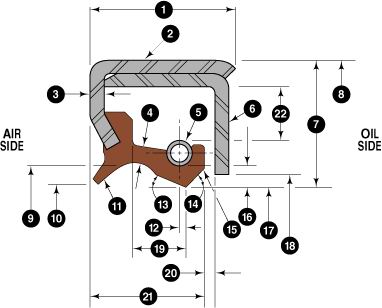
Garter
Spring – The garter spring is a helically
coiled wire with its ends connected to form a ring. It
is used to add
a constant load to the seal’s primary lip. The garter
spring compensates for the loss of lip force against the
shaft as the elastomer relaxes when exposed to elevated
temperatures over time. The garter spring is considered
essential when sealing low viscosity fluids or shafts rotating
at high RPM. (See chart page 10.)
Case – Metal
stamping to which the elastomer is bonded.
Seal
Width – Overall width of the seal.
Case
Thickness – Metal case thickness varies
based on size and application of seal.
Lip
Flex Thickness – The thickness of the primary lip
section between the spring and the case that flexes outward
when the shaft is installed through it. The thickness of
the flex section helps energize the lip against the shaft
and governs the seal’s resistance to pressure. It
also contributes to the amount of friction between the
lip and the shaft.
Inner
Case – A metal stamping incorporated within the outer
case to provide additional seal rigidity and to protect
the elastomeric lip during seal installation.
Radial
Section with Free Lip – The cross-section of the
seal measured from the outside diameter to the primary-lip
inside
diameter.
Outside
Diameter – The diameter of the seal’s outer
surface which is press-fit into its mating bore. This surface
provides the static sealing interface to the housing, as
well as mechanically locking the seal in the assembly.
Lip
Clearance Diameter or Heel Diameter – The seal’s
inside diameter which provides clearance with the shaft.
It is the surface of the seal’s inside diameter that
determines the flex section.
Dirt
Lip Diameter – The inside diameter of the air side
lip that is typically designed for only net contact with
the shaft to prevent additional frictional heat. This diameter
can be designed with shaft interference for increased dirt
exclusion at the cost of increased frictional heat.
Dirt
Lip – The dirt lip is located at the air side of
the seal to prevent contaminants from entering the assembly.
It is also used to retain grease.
R
Value – The axial distance between the lip contact
point and the centerline of the garter spring. The garter
spring is typically offset to the air side of the lip 0.25
to 0.75mm for optimum sealing.
Barrel
Angle – The angle between the seal centerline and
primary lip’s conical surface to the air side of
the seal. This angle should be approximately 30 degrees
to allow a meniscus of fluid to be retained between the
lip and the shaft. A properly designed seal rides on this
meniscus rather than the shaft itself to reduce friction
and wear.
Scraper
Angle – The angle between the seal centerline and
primary lip’s conical surface to the oil side of
the seal. This angle is typically 55 degrees and helps
to form the meniscus of fluid on which the seal contact
point rides.
Primary
Seal Lip – The lip located on the oil side of the
seal. It performs the principle dynamic sealing function.
If the seal utilizes a garter spring, it will be located
on this lip.
Head
Thickness – Head thickness is the radial distance
between the primary lip’s contact point and the spring
pocket.
Primary
Seal Lip Inside Diameter – The smallest diameter
of the seal primary lip. This diameter is stretched onto
the
shaft energizing the elastic properties of the lip creating
the dynamic interface for the assembly.
Inner
Case Inside Diameter – The smallest diameter of the
inner case designed to protect the lip from damage. It
protects against the spring becoming dislodged at assembly
and guarantees clearance between the inner case and the
shaft.
Beam
Length – The axial distance between the lip contact
point and the base of the lip flex thickness. Short beam
lengths provide greater resistance to internal pressure.
Longer beam lengths provide more flexibility to better
follow shaft eccentricities at higher RPM.
Axial
Lip Clearance – The axial distance between the
primary seal lip and the inside wall of the inner case.
This dimension is critical to ensure clearance between
the case and the lip after being installed over the shaft.
Lip
Length – The primary seal lip’s overall length
measured from its air side face to the back of the seal.
Radial
Spring Clearance – The radial distance from the outside
diameter of the garter spring to the inside wall of the
seal’s outer case. This clearance is important to
ensure free movement of the lip. |






